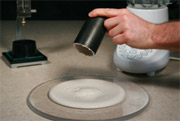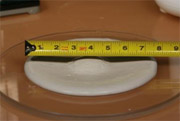Gypsum Lab Services
Stucco or Plaster Water DemandWater demand is defined as the amount of water needed to make a stucco slurry flow to a target degree of fluidity and can be expressed in terms of a volume of water per weight of stucco (mL/100g). Other terms used in the gypsum industry that are analogous to water demand are consistency or water:stucco ratio (WSR) which is a dimensionless fractional representation of the same value. In gypsum board manufacturing, water demand is very important to formulate mix water and superplasticizer additives and also to determine the amount of evaporation needed in the board line dryer. Energy used for board drying is often in the first few highest cost components of producing gypsum board and new product introductions of green "ecosmart" gypsum boards are based on reducing water usage and evaporation. To evaluate the water demand of a stucco or plaster, a good quality control test to use is the “machine mix” water demand test. This test is also commonly known in gypsum board manufacturing as a “slump test” and generally measures a slurry flow distance when released from a tube. Gravity acts on the fluid slurry which flows out of the tube and forms a patty. This test is used in quality control for gypsum board line slurry, gypsum board stucco and plasters products. Other tests that are also used for similar purposes are the hand mix vicat ring slump, modified vicat cone consistency, consistometer or ford cup tests. Innogyps has prepared a test method document which describes the steps involved in performing the machine mix water demand measurement. The purpose of this document is to help someone like a gypsum board plant quality control professional understand the specifics of the test, how it is performed and what the results mean.
|
  |